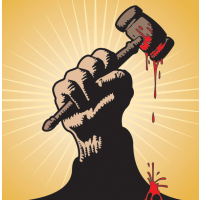Death Row Runs Out of Room

California has run out of room on Death Row for all the inmates it wants to kill, so rather than fix the system that led to this sad state of affairs, lawmakers are pondering making more space for them.
California hasn’t executed any inmates since 2006, but voters overwhelmingly reaffirmed in 2012 that it wants to keep the death penalty. Consequently, the list of condemned prisoners has grown from 646 that year to 751. Twenty are women, housed at the Central California Women's Facility near Chowchilla. The state would like to keep all the men at San Quentin, but Death Row only holds 715 people.
They haven’t hit the limit yet because nearly two dozen are in medical facilities, stashed in other state’s prisons or waiting in other lockups during court proceedings.
Paige St. John at the Los Angeles Times poked around in Governor Jerry Brown’s $113-billion, proposed budget (pdf) and noted that $3.2 million was set aside to expand Death Row by 100 cells. The budget anticipates around 20 new members a year. The new cells would actually be in old cell blocks and the money would mostly be spent on their special staffing requirements.
The budget proposal says the need is dire: “San Quentin would not have beds to accommodate the condemned should any return from court, outside medical facilities, or if SQ receives any newly condemned inmates.”
California hasn’t executed a prisoner since the U.S. Court of Appeals for the Ninth District told the state its preferred method of killing, lethal injection, required the participation of a doctor. Doctors wouldn’t do that. So the state proposed intravenous barbiturates. But the court said some kind of medical personnel had to be present for that and the state couldn’t find one who could get past the ethical issues.
The state Supreme Court ruled the state’s death penalty law was unconstitutional in 1972, which led to the commutation of 102 death sentences. That saved the lives of Charles Manson and Sirhan Sirhan. Voters almost immediately passed Proposition 17, reinstating the death penalty. But in 1976, following U.S. Supreme Court decisions that gutted and then restricted state death penalty laws, the state high court killed California’s again, leading to 68 more prisoners being resentenced.
Voters approved a new, broader death penalty law in 1978 and resumed executions in 1992. Prisoners were given a choice between lethal injection and gas. California outlawed the gas chamber in 1994.
Legal battles over lethal injection continued apace until July 2014, when U.S. District Judge Cormac J. Carney blamed the state for unconstitutionally delaying the death penalty process for years and reduced the sentence of Ernest Dewayne Jones to life in prison.
It wasn’t all about lethal injection.
The George W. Bush-appointed judge pointed out that the average inmate on Death Row waits three and a half years just to get a court-appointed lawyer. Then it takes another 12-14 years for the California Supreme Court to affirm the conviction. When California was killing inmates between 1978 and 2006, the average inmate was on Death Row for 17.5 years, according to the California Department of Corrections and Rehabilitation (CDCR)
Judge Carney wrote that the lengthy delay violates the Eighth Amendment prohibition against cruel and unusual punishment: “For all practical purposes then, a sentence of death in California is a sentence of life imprisonment with the remote possibility of death—a sentence no rational legislature or jury could ever impose.”
–Ken Broder
To Learn More:
California’s "Death Row" Has Run Out of Room as Condemned Inmates Pile Up (by Lawrence Bonk, IJ Review)
California's Death Row Has Literally Run Out of Room (by Debbi Baker, U-T San Diego)
California's Death Row, with No Executions in Sight, Runs Out of Room (by Paige St. John, Los Angeles Times)
California’s Death Row Has Just About Run Out of Room (by Darrell Saltzman, KCRW)
40 Years of Death Row: 1,359 Executed; 890 Convictions Overturned (by Noel Brinkerhoff, AllGov California)
- Top Stories
- Controversies
- Where is the Money Going?
- California and the Nation
- Appointments and Resignations
- Unusual News
- Latest News
- California Forbids U.S. Immigration Agents from Pretending to be Police
- California Lawmakers Urged to Strip “Self-Dealing” Tax Board of Its Duties
- Big Oil’s Grip on California
- Santa Cruz Police See Homeland Security Betrayal in Use of Gang Roundup as Cover for Immigration Raid
- Oil Companies Face Deadline to Stop Polluting California Groundwater





